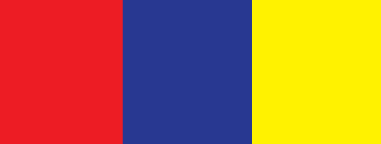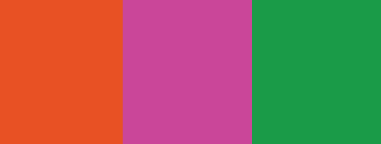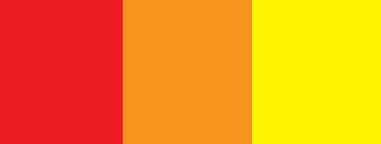The color wheel was developed by Sir Isaac Newton by taking the color spectrum and bending it into a circle. If you follow around the color wheel, you will find the same order of the color spectrum- red, orange, yellow, green, blue, indigo(blue-violet), and violet. Some remember it by the acronym ROY G. BIV.
The color wheel is made up of three different types of colors - Primary, Secondary, and Tertiary.
The primary colors are red, yellow, and blue. They are called primary for a couple of reasons. First, no two colors can be mixed to create a primary color. In other words, primary colors can only be created through the use of natural pigments. Secondly, all other colors found on the color wheel can be created by mixing primary colors together.
The secondary colors are orange, green, and purple. Secondary colors are created by mixing equal parts of any two primary colors. Yellow and blue will give you green. Red and blue will create purple(violet). Red and yellow will give you orange.
Tertiary colors are created by mixing equal parts of a secondary color and a primary color together. There are six tertiary colors- red-purple, red-orange, blue-green, yellow-green, blue-purple, and yellow-orange. Notice that the proper way to refer to tertiary colors is by listing the primary color first and the secondary color, second.
Color Theory Part -Color Schemes
Color schemes are ways colors are put together in an intelligent way
Monochromatic- literally means one (mono) color (chroma). So a monochromatic
color scheme is made up of one color and it’s shades and tints.

Analogous colors- are colors that are next to each other on the color wheel.
When used as a color scheme, analogous colors can be dramatic. Ex. Blue, blue-green, green, and yellow-green; red, red-purple, purple, blue-purple

Complementary colors- are colors found directly across from each other on the color wheel. Complementary color scheme provide strong contrast. Ex. Blue and orange,
red and green, yellow-green and red-purple.

Color triads- consist of three colors found on the color wheel that are equally spaced
apart from each other. Ex. Red, blue and yellow or orange, green and purple.

Split complementary- color schemes are made up of a color and it’s complements
closest analogous colors. Ex Blue, yellow-orange and red-orange. Red-orange,
red-purple, green.

Warm colors- colors that are usually associated with warm things. Ex. Red, yellow,
orange

Cool colors- colors that are usually associated with cool things. Ex. Blue, purple, green

Color schemes are ways colors are put together in an intelligent way
Monochromatic- literally means one (mono) color (chroma). So a monochromatic
color scheme is made up of one color and it’s shades and tints.

Analogous colors- are colors that are next to each other on the color wheel.
When used as a color scheme, analogous colors can be dramatic. Ex. Blue, blue-green, green, and yellow-green; red, red-purple, purple, blue-purple

Complementary colors- are colors found directly across from each other on the color wheel. Complementary color scheme provide strong contrast. Ex. Blue and orange,
red and green, yellow-green and red-purple.

Color triads- consist of three colors found on the color wheel that are equally spaced
apart from each other. Ex. Red, blue and yellow or orange, green and purple.

Split complementary- color schemes are made up of a color and it’s complements
closest analogous colors. Ex Blue, yellow-orange and red-orange. Red-orange,
red-purple, green.

Warm colors- colors that are usually associated with warm things. Ex. Red, yellow,
orange

Cool colors- colors that are usually associated with cool things. Ex. Blue, purple, green

Color Theory Terms and Definitions
- Color - Element of art derived from reflected light. We see color because light waves
- are reflected from objects to your eyes.
- Color wheel - color spectrum bent into a circle.
- Primary colors - The most basic colors on the color wheel, red, yellow and blue.
- These colors cannot be made by mixing
- Secondary colors - colors that are made by mixing two primary colors together.
- Orange, green and violet (purple)
- Tertiary colors - colors that are made by mixing a primary color with a secondary color
- Hue - the name of the color
- Intensity - the brightness or dullness of a color. DO NOT CONFUSE INTENSITY
- WITH VALUE.
- Color value - the darkness or lightness of a color. Ex pink is a tint of red
- Tints - are created by adding white to a color
- Shades - are created by adding black to a color
- Optical color - color that people actually perceive- also called local color.
- Arbitrary color - colors chosen by the artist to express feelings or mood.

No comments:
Post a Comment